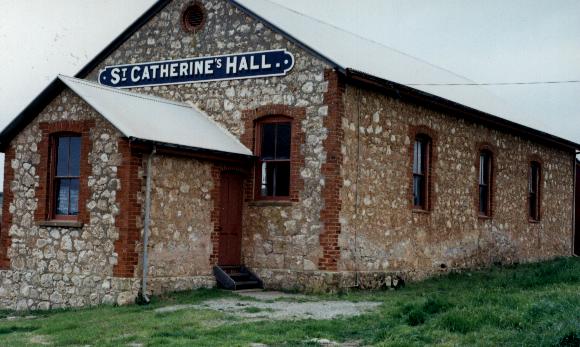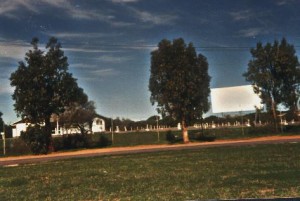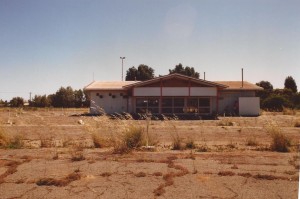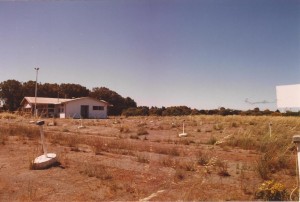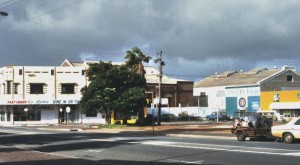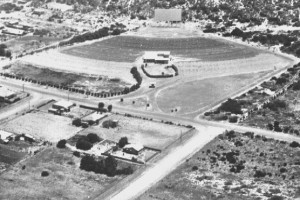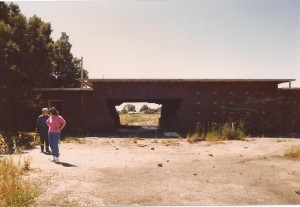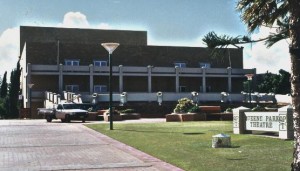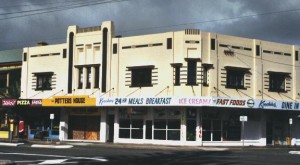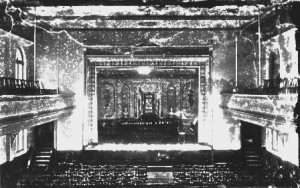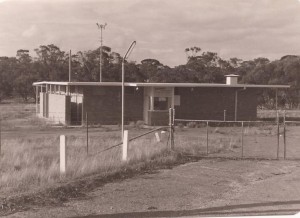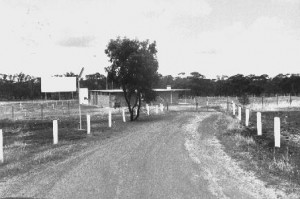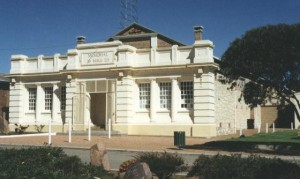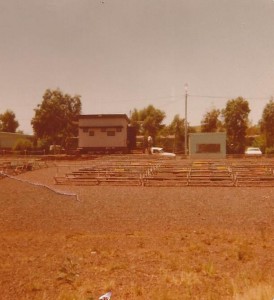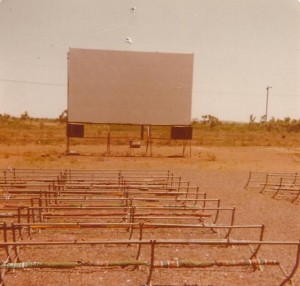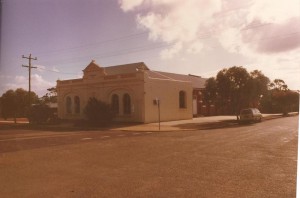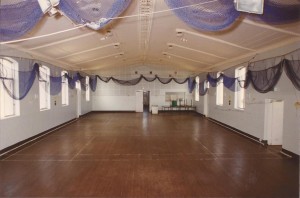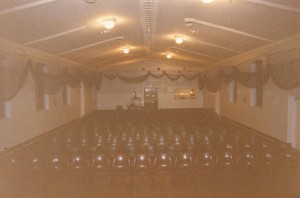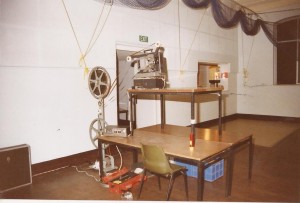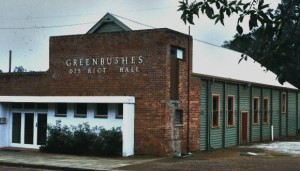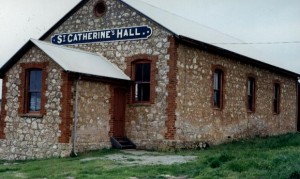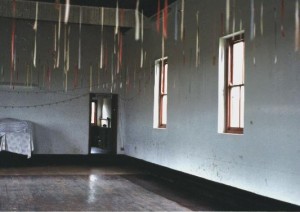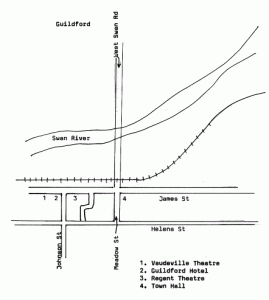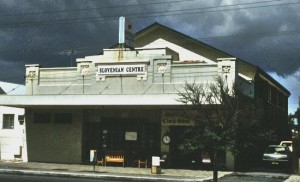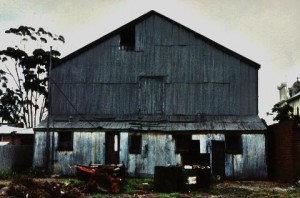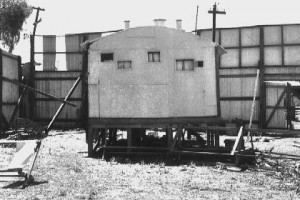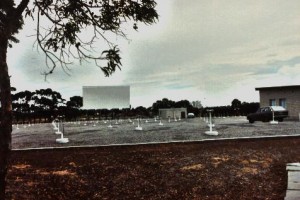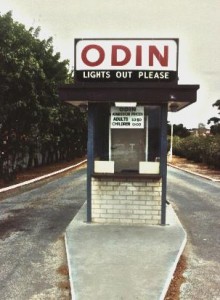Quicklinks
| Gabbin | Geraldton | Gingin |
| Gnowangerup | Goldsworthy | Goomalling |
| Gosnells | Grant’s Patch | Graylands |
| Greenbushes | Greenough | Guildford |
| Gwalia | Gwelup |
GABBIN
GABBIN HALL, Gabbin
Local historian F.H.Broomhall credits Paddy Baker with being the first to show films in Gabbin, probably in the town’s first small hall, certainly on 21 August 1922. He screened again later that year, and irregularly for some time after that.
Sources: F.H.Broomhall, Mount Marshall: a history of its people from earliest times to 1942 , Shire of Mount Marshall, 1983, pp.212, 244.
GERALDTON
BLUFF POINT DRIVE-IN/ GERALDTON DRIVE-IN, Strickland & Mitchell Sts, Bluff Point (Geraldton)
The third drive-in built in Geraldton was the Bluff Point Drive-in, on the south-east corner of the Strickland St and Mitchell St intersection, built by Jim Cook for a company in which Goldfields Pictures had a 25% interest, but run by Alan Larkin. It was opened soon after the Ozone (about 1965?) and was the only one still operating in 1986, closed in 1988. In 1997, the screen was still standing in an overgrown wilderness, still surrounded by a cyclone fence, and the land was advertised for sale.
Sources: Film Weekly Directory 1968/9 – 1971
Public Health Department, building permit, Battye 1459
Max Bell, Kino, no.24, June 1988, p.23
A.G.Wheat correspondence with Colleen Pead 1986
West Australian 1973 – 1985
Interview (Ina Bertrand): Alan Larkin
Photos: 1 exterior, colour, 1981, Bill Turner
2 exterior, 1989, Roy Mudge
KING’S HALL/ SOLDIER’S PICTURES/ KING’S PICTURES/ RADIO PICTURES, 15 Fitzgerald St, Geraldton
The King’s Hall had been built in 1911 by Dick Cordelier, next door to the Shamrock Hotel, on the north of Fitzgerald St, just up from the corner of Marine Terrace. By 1913 there were occasional film screenings or weekly seasons in the hall, and after the war a syndicate of local businessmen set up “Soldiers Pictures” in King’s Hall, now called the King’s Theatre, using the proceeds to assist the rehabilitation of returned servicemen.
In 1921 Alfred Wheat arrived in Geraldton to manage this business, and some time later (before 1930) he bought out the syndicate and renamed the enterprise “Radio Pictures”, though still operating from the King’s Theatre. He then consolidated the screenings (which had been in both the King’s Theatre and Queen’s Hall), and he had a monopoly in the town by 1930 when the changeover to sound occurred. Raycophone sound gear was installed, additional seating was provided, and “flowing curtains… were suspended at vantage points around the hall” (Geraldton Guardian 23 Dec.1930) for the inaugural presentation, on Saturday 20 December 1930. The Guardian reporter explained the delay in the arrival of the new technology as a result of the proprietor’s desire to provide the very best equipment, and the full house which enjoyed Bulldog Drummond and Tanned Legs on the opening night seemed well pleased with the result.
In fact, the business prospered sufficiently for a new Radio Theatre to be included in a major development on the corner of Fitzgerald St and Marine Terrace. When this opened in April 1937, the old theatre building was absorbed into the motor vehicle business of the Wheat family, the interior stripped and modified as a workshop. The building was still standing when it was sold in April 1986, and in 1997 was in use as an indoor archery centre. The entrance was once down a lane off Marine Tce, but is now in Fitzgerald St, behind shops.
Sources: A.G.Wheat correspondence with Colleen Pead 1986
Geraldton Express, 27 September 1924
Geraldton Guardian and Express, 10 April 1937
Geraldton Guardian, 23 December 1930
Photos: 1 exterior, colour, 1997, Graeme Bertrand
OASIS DRIVE-IN, 175 North-West Coastal Highway, Wonthella (Geraldton)
The Oasis was the first country drive-in in the state. It opened on 13 May 1957, on twelve acres on the west side of the North West Coastal Highway, opposite Place St and First Ave, in Wonthella, a northern suburb of Geraldton. The land cost £1,500, and all the planning and surveying for the site was done by the owners, brothers Noel and John Glass, who then employed contractors to do the earth moving and construction. The aspect of the venue most vulnerable to the weather, and particularly the high winds that had prevented earlier open air premises in this district, was the screen:
The screen, designed to permit the showing of Cinemascope films, measures 38ft x 80ft and is supported on a frame 58 feet in height. The frame is composed of 6-inch and 5-inch tubular steel pipes, with 1 1/2 inch braces. To it have been attached timber girts which hold the sheets of zinc anneal forming the screen itself. These have been given four coats of paint on the theatre side, the final one being “screen white”. The whole structure weighs in the vicinity of twenty tons and supports are anchored in 100 tons of concrete. (Geraldton Guardian, 11 May 1957)
But it was also necessary to explain to potential patrons, who could not be expected to have ever seen a drive-in theatre before, just what the experience might be like. Noel Glass addressed the Rotarians on the subject, and the local paper explained further:
There are two entrance roads to the theatre, these passing on either side of the ticket box and leading to the terraces. These terraces are so constructed that the cars occupying them have the front section slightly elevated so that occupants have a direct view of the screen which, incidentally, leans forward to the extent of two feet. From any portion on the terraces, those in the cars will have a completely uninterrupted view of the films and this will not be marred either by cars or pedestrians that may move between them and the screen.
Each vehicle will be provided with its individual in-car speaker, which can be adjusted by the users. The only sound that will be heard from the theatre when it is in operation will be from the speakers provided for patrons sitting in the lounge and those within the concession building. (Geraldton Guardian 11 May 1957)
The locals, however, found the presence of the drive-in an unexpected asset. In the Geraldton Guardian of 17 April 1958, the President of the Wonthella Progress Association (G.K.Allen) was reported to have said that “without the theatre not so much work would have been done on the roads at Wonthella”. He may not have been so pleased on the first anniversary of the opening of the venue, when the crowd for the birthday celebrations caused a traffic jam in surrounding streets.
The Oasis had a permit for 450 cars and 200 seated patrons. It opened with a capacity for 289 cars, on seven ramps, and seating for about sixty walk-in patrons in the downstairs section of the concession building. However, it was so successful that that capacity was increased – to 354, to 450 and finally to 615 on twelve ramps by the end of 1963. It was completely filled to capacity only once – for Shenandoah, with James Stewart.
The venue closed on 15 May 1985, and the land was sold to Bunnings who built a hardware and garden store there.
Sources: Film Weekly Directory 1957/8 – 1971
Public Health Department, building permit, Battye 1459
Max Bell, Perth – a cinema history, The Book Guild, Lewes Sussex 1986, p.138
Max Bell, ´Drive-ins of Western Australia’, Kino, no.46, December 1993, p.28
Film Weekly 28 May 1959, p.11
Geraldton Guardian 2 March 1957; 11 May 1957; 14 May 1957, p.8; 16 May 1957, p.10; 17 May 1957, p.2; 15 May 1958, p.10; 17 April 1958, 17 September 1964; 3 June 1977, p.5; 5 February 1985, p.1, 14 February 1985, p.1
Interviews (Ina Bertrand): Ron Elsegood, John Glass (1997)
Photos: interior, biobox, b&w, Max Bell, ´Drive-ins of Western Australia’, Kino, no.46, date, p.28
1 exterior, b&w, Geraldton Guardian 11 May 1957, p.1
exterior, b&w, approx.1958 (colour copy taken from photo held by John Glass)
OZONE DRIVE-IN, Blencoe Rd, Utakarra (Geraldton)
The Glass brothers opened Geraldton’s second drive-in, the Ozone, on the south-east corner of the intersection of Blencowe Rd and Utakarra Rd, on 21 September 1964. There was room for 245 cars on the ten-acre block, which was beautified with trees and shrubs, providing some wind protection. The block had a slight slope and the screen was four feet wider than that at the Oasis. The opening night was offered as a benefit to two local groups – St John Ambulance, and the Men’s Hockey Association. The Ozone was the first of Geraldton’s three drive-ins to close, in (1977?). In 1997, the concession building and screen were still standing in a wilderness of grass and overgrown shrubs, and the land, which was still owned by the Glass family, was for sale.
Sources: Film Weekly Directory 1964/5 – 1971
Public Health Department, building permit, Battye 1459
Max Bell, Perth – a cinema history, The Book Guild, Lewes Sussex 1986, p.138
Max Bell, ´Drive-ins of Western Australia’, Kino, no.46, December 1993, p.28
A.G.Wheat correspondence with Colleen Pead 1986
Geraldton Guardian 17 September 1964
West Australian Magazine, January 1996
Interview (Ina Bertrand): John Glass (1997)
Photos: interior, biobox (date?), b&w, Max Bell, ´Drive-ins of Western Australia’, Kino, no.46, p.28
exterior, biobox (date?), b&w, Max Bell, ´Drive-ins of Western Australia’, Kino, no.46, p.28
1 exterior , colour, Roy Mudge
QUEEN’S HALL, Cathedral Ave, Geraldton
This hall was built/owned by Dan Marsh who operated a woodyard on the corner. By 1913 there were occasional screenings or weekly seasons of films in this hall and by the middle of the year regular screenings were being provided by Perth exhibitor H. E. Seguy. Live shows and skating were also presented in the hall at this time. By the end of World War 1, Seguy’s business had been taken over by the Marsh family, who were in turn bought out by Alfred Wheat who amalgamated the screenings with those in the King’s Theatre.
In later years, Queen’s Hall had a reputation as a ´flea pit’. When the building was sold, Bennett’s Elite drapery built there, and no trace of the original building now remains.
Sources: Max Bell, Perth – a cinema history, The Book Guild, Lewes, Sussex, 1986, p.118
A.G.Wheat, correspondence with Colleen Pead, 1986
Geraldton Guardian 1913 – 1919
QUEEN’S PARK THEATRE, Cathedral Ave, Geraldton
The Queen’s Park Theatre was built on the northern corner of Maitland St, for the City of Geraldton, with some financial support from the State government and the Shire of Greenough. It was designed by architects Hill, Parkinson and Harris to seat 660 patrons, and opened with a spectacular season of live musical and theatrical performances from 27 March to 4 April 1982.
Films were at first screened irregularly, then regular seasons began, interrupted whenever a live performance required the venue. In early 1996 it was reported that the management proposed the addition of a 250-seat cinema and 150-seat theatrette on the Maitland St side of the existing building.
Sources: Max Bell, Kino, no.34, December 1990, p.24; ´Dongara-Geraldton trip: Western Australia’, No.56, June 1996, p.30
Souvenir programme, opening season, March 1982
Queen’s Park Theatre file, Geraldton Library, Local History Collection
West Australian, 27 March 1982
MWT, 24 January 1996
Photos: 1 exterior, colour, 1997, Graeme Bertrand
RADIO THEATRE, 207 Marine Terrace, Geraldton
Radio Pictures, in the old King’s Theatre, prospered sufficiently for Alfred Wheat to decide it was time for new premises. He persuaded the trustees of the T.G.Kitching Estate (which owned the land on which both the old and new theatres stood) to include a cinema in a major development on the north-east corner of the intersection of Fitzgerald St and Marine Terrace:
The new block of buildings with its two storied frontage, finished in plaster, presents an attractive appearance. It comprises the theatre, a service station, motor show rooms, and two shops, whilst on the upper storey there are four modern flats. (Geraldton Guardian and Express, 10 April 1937)
The old theatre was gutted and used for a motor vehicle business. The new Radio Theatre, designed by S. Rosenthal and built by Richard Cardilini, cost £12,500, and was leased to Wheat. It opened on Friday 9 April 1937:
The vestibule is wide and is fitted with swing doors as a protection from the weather. Within the vestibule is the glass-enclosed ticket office, and flanking the vestibule there is the office on one side and on the other a ladies rest room and a room for parking perambulators, a convenience which will be greatly appreciated by mothers. The circle is reached by a wide staircase, and at the top on either side there are lounges, comfortably furnished with chairs and couches, whilst there is also a retiring room for ladies. The interior of the theatre has been designed to afford the maximum comfort possible, and it will provide accommodation for nine hundred people…The seats are all of the tip up variety, nicely upholstered in leather. A facility that will be much appreciated will be the marked slope, both of the auditorium and the circle, which will enable everyone to obtain a good view, which was not always possible in the old building. In addition, much greater space has been provided between the rows of seats, a consideration which will also be viewed with favour, whilst the seats are also wider. The lighting has received special attention, and is afforded by lights in the ceiling of the auditorium and circle. The walls and ceilings have been enriched with fibrous plaster, the general effect being very striking and cool looking. The ventilation…is effected by means of roller shutters, which will meet summer as well as winter requirements, whilst carpets in the lounges, staircases, aisles and other floor furnishings all combine to add an air of comfort to the building. (Geraldton Guardian and Express, 10 April 1937)
The theatre also had full stage facilities to enable use for live shows, both local productions and visiting companies. The red neon sign was not only the first such sign in Geraldton, but was considered by some to be a danger to shipping – though it was regarded affectionately by others as a landmark. After World War 2, when the building was again renovated, it was the first to introduce fluorescent lighting to the district. By the time Wheat sold out the business to Goldfields Pictures in 1951 he was recognised as one of the pioneers of the film industry in the state.
At the same time as they bought the goodwill of the Radio Theatre, Goldfields bought land next door with the intention of constructing a picture gardens. The locals advised against it, but it was not till W.R.Clemenger himself spent a week in the town, and felt at first hand the strength of the southwesterly winds, that he agreed that a gardens was impractical and Goldfields sold the land. They continued screening in the theatre till 29 October 1971. About 1983?/6? plans were made to re-open the theatre, installing seats from the old Cremorne Theatre in Kalgoorlie, and this was done under a syndicate headed by Dan Cunningham. However, in 1988 it closed again soon after its fiftieth birthday, and was sold for conversion into a pool parlour, which entailed demolition of the gallery. In 1990 it was classified by the National Trust, and in 1996 it was used by Potter’s House Christian Community.
Sources: Film Weekly Directory 1940/41 – 1971
Post Office Directory 1930-1949
Max Bell, Kino, no.24, June 1988, p.23; ´Dongara-Geraldton trip: Western Australia’, no.56, June 1996, p.30
Max Bell, Perth – a cinema history, The Book Guild, Lewes Sussex 1986, p.119-120
Vyonne Geneve, Significant buildings of the 1930s in Western Australia, Vyonne Geneve, June 1994, National Trust of Australia (WA)/ National Estate Grants Programme 2 vols
A.G.Wheat correspondence with Colleen Pead 1986
Geraldton Guardian, 3 April 1971, 28 October 1971, 16 June 1988, 12 April 1990, 1 May 1990
Geraldton Guardian and Express, 10 April 1937, October 1971 (check October 1971 – not seen)
Interview (Ina Bertrand): Ron Elsegood
Photos: 2 exteriors, colour, 1997, Graeme Bertrand
TOWN HALL, Chapman Rd, Geraldton
Geraldton was visited by the Salvation Army Biorama Company (September 1900, August-September 1902, February 1904, December 1904) and by Heller’s Mahatma Company in February 1901, but it is not known where these screenings took place. They were not in the Town Hall, which was built in 1907, in time to be the venue for the Musical All-Blacks and Page’s Supreme Pictures in July 1908, and the Corricks in October 1909. In June 1913, the Municipality of Geraldton were calling for tenders for the lease of the hall for picture shows or vaudeville three nights a week, and there were certainly films there for some time in 1915. Soldiers Pictures began at the Town Hall in October 1919, but moved almost immediately to the King’s Hall.
In 1951/2, Paddy Baker was registered in the Film Weekly Directory as the exhibitor in the Town Hall, and from 1951/2 to 1961/2 Goldfields Pictures were listed at the Town Hall. In the fifties, the hall held around 650, and was operating in competition with Alfred Wheat’s Radio Theatre. Then Goldfields announced plans to develop a drive-in (which may have been the Bluff Point Drive-in). Screenings in the Town Hall ceased once the third drive-in was open. In the nineties, the old Town Hall was used as an art gallery.
Sources: Film Weekly Directory 1951/2 – 1960/61
A.G.Wheat correspondence with Colleen Pead 1986
West Australian 1901-1909
Photo: 1 interior, set up for Corricks 1909, b&w, John Corrick
GINGIN
HALL, Gingin
The Gingin Agricultural Hall was built in the 1890s, as a simple timber-framed corrugated iron building, with a stage at one end. Improvements and additions (including a Supper Room) were made in 1912, and the venue was administered by a local committee.
Local historian, Hazel Udell, explains:
Moving picture shows were also very popular; the Star Picture Co, Hazell’s Pictures and Spencer’s Picture Co. all made regular visits to Gingin. The Committee decided that a fireproof cabinet was a necessity, so that the projectors could be housed with safety in a permanent position in the hall and Mr W.R.Turner was engaged to erect this projection room. During 1914, the Committee also agreed that an acetylene gas plant should be installed at the hall though nothing was done immediately. Several years later Mr Pearse Herbert purchased a gas plant from the Church of Christ in West Guildford. A shed had to be erected to protect the gasometer – the total cost was £14 including installation. (pp.236-7)
But the cost of maintenance of the hall became too much for the committee. They sold the gas plant, and in 1925 gave up responsibility for the hall to the Road Board, which made substantial repairs in 1933 and 1938. By the thirties, Gingin had a lesser hall and a main hall, with the bio-box on pillars outside – in winter the wind would make the whole structure sway. Alan Larkin was listed as the exhibitor in the late fifties, followed briefly by W.G.Wyles.
In the middle sixties, John Marsden was working at the Windsor, Nedlands, and screening on his night off on his own behalf. He had tried Brunswick Junction, Dwellingup and Lancelin, before he closed all these and moved his Sunday night screenings to Gingin, where he stayed for about thirteen months.
Sources: Film Weekly Directory 1958/9 – 1960/61, 1968/9 – 1969/70
Hazel Udell, A history of Gingin, 1830 to 1960, Gingin Shire Council 1979
Interview (Ina Bertrand): John Marsden (1997)
GNOWANGERUP
AGRICULTURAL HALL, Gnowangerup
The foundation stone of this hall was laid on 28 March 1910 and it was completed by 20 May 1910. It was used for all community activities until the Memorial Hall was opened in 1923, so this was probably the location for the screening of the Tivoli Picture Co of Katanning, which visited the town in 1915-16.
Sources: Patricia Penfold, ´’Public halls: a display of settlers’ optimism’, Gnowangerup Star, 30 March 1995 Gnowangerup Star 1915-16
GNOWANGERUP/AYLEMORE? DRIVE-IN
This drive-in was built on the north side of the highway, opposite the junction with Walsh Rd.
The first advertisements for Gnowangerup Drive-in appear in August 1964, but without any notice of an official opening date. It seems to have been built by Les Kanzler, operated by him, by his wife after his death and by various lessees. It was run in conjunction with Katanning Pictures – films were shown first at Katanning, then the next day at Gnowangerup. It opened and closed several times in the seventies, when Jack Tilka leased it from Ramsays of Subiaco. After it closed, the property was sold, and in 1997 the site was used for a house, with no sign that a drive-in ever existed there.
Sources: Film Weekly Directory 1964/5 – 1971
Public Health Department, building permit, Battye 1459
Max Bell, Perth – a cinema history, The Book Guild, Lewes, Sussex, 1986, p.135
Max Bell, Kino, no.13, September 1985, p.14
Great Southern Herald 14 August 1964
Interview (Ina Bertrand): Roy Mudge (1997)
Photos: 8 interiors (biobox, concession), b&w, 1977, Roy Mudge
12 exteriors, b&w, 1977, Roy Mudge,
1 exterior, b&w, 1980s, Max Bell
MEMORIAL HALL, Yougenup Rd, Gnowangerup
The Memorial Hall was built in 1923, funded by local donations as a memorial for the veterans of World War 1. It is located in the main street, flanked by the Post Office on one side and the Lesser Hall on the other. It was opened in August 1923 and the Municipal Heritage Directory describes it as constructed of ´sandstone blocks with brick batts around the doors, front is bricked with iron roof, timber floor and stage inside’.
In the twenties Pratt’s Pictures (operated by Albert Pratt) presented weekly screenings, in the thirties the town was on Bart Mott’s Star Entertainments circuit, and by the forties, P.J.(Joe) Rourke’s circuit operating out of Kojonup, visited Gnowangerup for a short time, before Rourke sold the business to D.C.Thornton. From the early fifties to the mid-sixties, it was on the Kanzlers’ circuit out of Albany, and screenings in the hall ceased when the Kanzlers opened the drive-in.
In the eighties, first Roy Mudge of Perth, then Frank Terry of Wagin occasionally visited the town, but these screenings also ceased.
Sources: Film Weekly Directory 1940/41 – 1964/5
Shire of Gnowangerup, Municipal Heritage Directory
Post Office Directory 1929-1944
Max Bell, Perth – a cinema history, The Book Guild, Lewes, Sussex, 1986, p.110
Pearl Marshall, Gnowangerup – the town: my story, Pearl Marshall 1993, p.41
Everyone’s 9 May 1928, p.34
Gnowangerup Star, 30 March 1995, p.3
Interviews (Ina Bertrand): Charles Legg (1997), Roy Mudge (1997), Brian Rourke (1997), Frank Terry (1997)
Informant: Mrs Rourke (Bullcreek 1997)
Photos: 4 exteriors, b&w, 1923 and later, Shire of Gnowangerup, Municipal Heritage Directory
1 interior, b&w, 1930, Shire of Gnowangerup, Municipal Heritage Directory
1 exterior, colour, 1997, Graeme Bertrand
1 exterior, b&w, n.d. Merle Bignell, The fruit of the country: a history of the Shire of Gnowangerup, Western Australia, Shire of Gnowangerup, 1977, opp. p.231.
GOLDSWORTHY
GOLDSWORTHY GARDENS /DRIVE IN
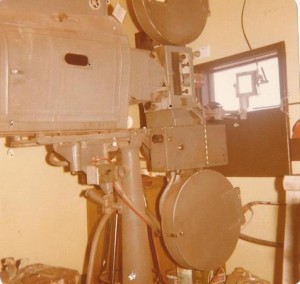
The town of Goldsworthy was the first of the new closed mining towns in the Pilbara, built by Goldsworthy Mining Ltd/ Hammersley Iron Ore Co. In 1967 the company built an open air picture venue, and N.J.Woods, who specialised in providing film screenings in the isolated communities of the north, contracted to supply the programming. 250 people could sit on canvas deckchairs, and cars could park behind the seats. Sound for both the cars and the seated audience was provided by loudspeakers. Screenings thrived, despite the provision of closed-circuit television to the town from as early as 1969. In 1980, Woods was supplying film to the Tom Price circuit which included Finucane Island and Shay Gap, as well as Goldsworthy. All these screenings were provided free to company employees.
Sources: East Pilbara Shire Community Directory 1981-1982, p.37
Film Weekly Directory 1968/9 – 1971
Max Bell, Perth: a cinema history, The Book Guild, Lewes, Sussex, 1986, p.110
Showman, 15 June 1967, p.16
Interview (Ina Bertrand): N.J.Woods (1985)
Photos: 2 exterior, sepia, 1980, Max Bell,
1 interior, sepia, 1980, Max Bell
GOOMALLING
MECHANICS INSTITUTE/ GOOMALLING WAR MEMORIAL HALL, Hoddy St, Goomalling
The Mechanics Institute Hall was opened on the corner of Hoddy and Quinlan Sts in 1911 and the War Memorial Hall replaced it on the same site in 1922. The new hall had a built-in bio-box, and Reg Mee showed films there every Saturday night: he opened the power station in 1922 and put in a special 80 volt power line for the films.
From 1926 to the end of 1929 Mee had competition from the open air pictures behind Turner’s garage. Both screened on Saturday night because that was late night shopping – till 9 p.m., so the film programme did not start till 9 p.m. either. People came in to town for shopping, ate in town, went on to the pictures: at that time there were many contractors in the district as well as the farming people. Reg Mee screened a two-night season of For the Term of his Natural Life in Goomalling in 1928, with great success. After the open air venue closed, Mee continued in the Town Hall till his death in 1934.
For some years, there were no films screened in the town, then Paddy Baker screened weekly in 1943, till the regular screenings were taken over by two local men – Pitman and Brewerton.
Ray Pitman was a power station engineer, who had bought the power station from Mee. Pat Brewerton was a farmer. From 1943 they went into the pictures together, at the Town Hall. They made improvements to the hall, such as metal frame deckchairs to replace the wooden seats (deckchairs were placed down the middle of the hall, wooden seats on either side). Rowdy teenagers used to gather in the permanent seats in a back corner. In 1946 it was usual to book seats at Garnet Royal’s chemist shop, and some people had permanent bookings, such as Charlie Johnson who sat on the aisle with his peanuts.
Pitman and Brewerton considered putting in a drive-in beside the hall, modifying the bio-box to be able to screen out through the side wall – but did not proceed with this idea.
Screenings in the hall ended in the early sixties: Roy Mudge purchased the projectors and installed them in turn in Boddington, Albany, Bridgetown, Midland, Waroona and back to Boddington (the most travelled projectors in the West?).
Sources: Film Weekly Directory 1940/41 – 1961/2
Public Works Department, correspondence over building permit, Battye AN 7/10 AC 1004 2069/26
Post Office Directory 1947, 1949
Everyone’s 28 March 1928, p.28
Informants: Col Eaton (Goomalling, 25 August 1997), Frank Schell (Goomalling, 25 August 1997) , Roy Mudge (1997)
Photos: 1 exterior, sepia, 1996, Max Bell, 3 interior, sepia, 1996, Max Bell
OPEN AIR PICTURES, Throssell St, Goomalling
Goomalling Open Air Pictures opened behind Turner’s garage in Throssell St on 22 December 1926 in spite of the fact that Health Department requirements had not been met. Negotiations continued over the summer over the lining and ventilation of the biobox, then the cinema stopped operating for the winter and the inspector reported that it may not be re-opened because the premises might be used for another purpose. Final approval was granted 14 December 1927, and it was indeed re-opened for the next two summers.
The venue had the usual high corrugated iron wall and deckchairs, and it screened on Saturday night in competition with the Town Hall. Because that was late night shopping which closed at 9 p.m., the screening did not start till 9 p.m. either, after the contractors and farmers had completed their shopping and had their dinner in town.
The open air venue closed about the end of 1929 – though the screenings in the Town Hall continued.
Sources: Public Works Department, correspondence over building permit, Battye AN 7/10 AC 1004 2069/26
Informants: Col Eaton (1997), Frank Schell (1997)
GOSNELLS
GOSNELLS HALL AND GARDENS, Wheatley St/Dorothy St, Gosnells
Gosnells hall was built in Wheatley St – a timber and galvanised iron boatshed, moved in 1912 from Mongers Lake. A local committee had raised £200 by debentures to cover the cost of building materials, and local people contributed the labour for re-erection in a ´Busy Bee’. It was a 40ft by 80ft unlined building lit by kerosene lamps hung from oregon beams. Mr Griffiths (secretary of the committee) sat behind the screen providing sound effects for the silent movies, and power for the projector was provided by a 20hp kerosene engine. The first seating was planks on milk crates. The screenings were used to raise money for the cost of the hall and for improvements. In 1917, Curtis and Co. bought the iron cladding and replaced it with weatherboards. Later the hall was lined and a supper room built, and still later a ´lesser hall’ was added.
In December 1926, G. Devereux screened in Armadale and Gosnells on alternate Friday and Saturday nights. In January 1927 a second operator, brothers L.L and E.F.Mackey tried to establish a rival show in Gosnells, on alternate Saturday and Friday nights, and in February they took over from Devereux, their first screening in the hall being White Sister on 5 February 1927.
Cyril Mackey remembers the construction of the gardens:
My father and my older brothers Len and Eric constructed a large picture screen and control room at each end of what was then the side lawn approximately 34 metres long by 18 metres wide, furnished with deck chairs. It became the first open air movies in Gosnells and opened in the Spring of 1928. With the innovation of talking films, the cost of amplification was prohibitive for open air movies and the entire unit was moved to the Public Hall in Wheatley Street and was later taken over and managed by Mr Len Martin.
Before 1943, R.R.Perrie, who had a small chain of venues in the southern suburbs, started screening in the hall, which by then held 250 people. In 1953 the management passed to Consolidated Pictures, who upgraded the building to hold 400 and redecorated, including new seating, carpets and neon lighting. Usherettes in blue and gold uniforms showed patrons to their seats on Wednesday, Friday and Saturday nights, and there was a matinee on Saturday afternoons. Around the corner, behind the hall, a gardens holding a further 400 was opened by the end of 1954, with its entrance in Dorothy St.
In February 1960, the Roads Board agreed to waive rental on the gardens site for two years because income had declined dramatically over the previous five years: in addition to television, the impact of the drive-in was noted and also the move towards hire purchase which had altered families’ financial commitments. By December 1962, Consolidated Theatres wanted to pull out of the lease altogether, and further negotiations allowed them to do this without paying back rental. The lease was terminated and Consolidated vacated the premises by March 1964.
In 1997, there was no sign of where the hall had stood.
Sources: Max Bell, Perth – a cinema history, The Book Guild, Lewes, Sussex, pp.58, 66
Coastal Districts Star 18 June 1953, 25 June 1953, 2 July 1953
Film Weekly, 2 July 1953, p.3
Film Weekly Directory, 1943/4 – 1961/2
South Western Advertiser 6 October 1949
Swan and Canning Times 3 December 1926, 7 January 1927, 21 January 1927, 4 February 1927, 4 March 1927, 11 March 1927, 6 January 1928, 14 March 1930
West Australian, 1953 – 1962
Informant: Cyril Mackey (letter to Gosnells City Council, 4 June 1997)
OPEN AIR CINEMA, Albany Hwy, Gosnells
From the early fifties, Bart Mott had a picture gardens in Albany Hwy. In January 1955 he opened a drive-in beside the gardens: patrons drove their cars onto the site and the sound was broadcast. Westrex installed amplifiers for this, and later also car speakers, but the venue never had properly-built ramps and Mott was constantly in dispute with the local council over building regulations. There were some seats under cover as well, so the cinema was able to open winter and summer. Parking problems resulted from the proximity of this venue to the screenings in the hall.
Sources: Film Weekly Directory 1951/2 – 1957/8
Coastal Districts Star, 27 January 1955
Interview (Ina Bertrand): Alan Crew (1997)
GRANT’S PATCH
HALL, Grant’s Patch
Grant’s Patch is another of the boom towns of the eastern goldfields. It was founded after the discovery of gold there in 1893, but by 1933 the population had shrunk to only 65, nearly doubling to 125 in 1947, then slowly disappearing by the 1960s, till in the 1990s there was no sign that the town ever existed. Tourists still visit it as one of the district’s ghost towns, and to fossick for gemstones in a rich area nearby.
Don Hancock (in the 1990s, publican at Ora Banda) grew up in Grant’s Patch, and can remember that the hall there was built of corrugated iron over an oregon timber frame, and that it had a bio-box. He can remember regular screenings there, and himself saw Lassie Come Home there. Eileen Moroney remembers hearing that ‘an Afghan’ (probably George Ilham – see also Esperance) occasionally visited in the days of silent films – perhaps every six months. The building was pulled down in the mid-1950s.
Sources: Tourist brochure
Informants: Don Hancock (1999), Eileen Moroney (1999)
Photo: not shown (Goldfields Historical Society?)
GRAYLANDS
GRAYLANDS GARDENS, Graylands
This simple gardens opened in 1952 and was closed by the early sixties.
Sources: Film Weekly Directory, 1953/4 – 1960/61
West Australian, 1952 – 1956
GREENBUSHES
MINERS INSTITUTE HALL/ GREENBUSHES DISTRICT HALL, Blackwood Rd, Greenbushes
The Miners Institute Hall was built at the far end of Blackwood Rd, on the east side, in 1897. The Municipal Heritage Inventory describes it like this:
..It was constructed of jarrah weatherboards on a timber frame with a corrugated iron roof. The building had a new brick front section added in 1959 and also steel portal frame structure added to the rear section for additional structural support. The building shows evidence of a bio-box and stairs added at the front and was probably used for showing movies from the 1920s or 30s.
In fact, there is evidence that movies were screened there much earlier. The Salvation Army screened in the town in October 1900 and again in October 1904. Heller’s Mahatma Company (from India, but screening mostly Boer War films) screened in the hall in 1906, and the Corricks brought Leonard’s Beautiful Pictures in August 1907 and again in 1909.
Greenbushes hall was on the fortnightly circuit of Modern Photoplays in the thirties. In 1939 Goldfields Pictures (founded in 1933 in Kalgoorlie) bought out the Greenbushes operator and included the town on their circuit, which also included Harvey, Donneybrook, Bridgetown, and Boyup Brook, using a program sent out from Bunbury by manager Ron Elsegood and switched among the five venues. Mrs Elsegood travelled out from Bunbury with an operator from Harvey one night per week. In 1947-8 Goldfields sold to Allan Jones, and the town became part of his second Manjimup circuit. But the locals decided they could do it themselves, and asked Jones to leave. They continued screening, but with such poor equipment that the distributors became reluctant to supply them with films. When they realised they needed expert advice they asked Jones to resume, but he refused. From 1948 to 1965, the town is listed in the Film Weekly Directory as part of the circuit of A.H.Jeffries, known as South West Picture Co., but it is not clear just when screenings ceased.
Sources: Film Weekly Directory 1940/41 – 1945/6, 1948/9 – 1964/5
Shire of Bridgetown/ Greenbushes, Municipal Heritage Inventory, HCWA no.12 0269
Interview (Ina Bertrand): Ron Elsegood (1985)
Interview (Ina Bertrand & Irma Whitford): Allan Jones (1978)
Informant: Ken Alexander (1986)
Limelight Picture Show Tours, http//:www.abc.net.au/limelight/docs/tours
Photo: 1 exterior, colour, 1997, Graeme Bertrand
GREENOUGH
ST CATHERINE’S HALL ,Old Highway, Greenough
Greenough Historical Hamlet was opened to the public on 19 May 1979. It is a collection of carefully-restored buildings on either side of what was once the highway, but is now a cul-de-sac running beside the Brand highway. In the nineties, services were still held in the churches, and some of the buildings were rented for weddings and other activities, but it was virtually a ghost town, operated as a tourist attraction by the National Trust.
The earliest screening in the town seems to have been a presentation of the Salvation Army Biorama Company, which visited in September 1902, but it is not clear which venue was used for this screening. St Catherine’s Hall is close to St Catherine’s Anglican Church. It was built in 1914, and in the mid-nineties was the venue for a monthly dance. It has a sprung timber floor, a kitchen and toilets, and no stage now (though it did have one in the early days). It was used occasionally for silent film screenings, though it did not have a built-in bio-box. After sound arrived, screenings ceased, and the local people travelled in to Geraldton for pictures. During World War 2 occasional films were screened there by the army.
Sources: The Heritage of Western Australia: the Illustrated Register of the National Estate, Macmillan 1989, pp.118-121
Max Bell, Perth – a cinema history, The Book Guild, Lewes, Sussex, 1986, p.110
Informants: Joy Freytag-Clinch, Ian Clinch (1997)
Limelight Picture Show Tours, http//:www.abc.net.au/limelight/docs/tours
Photos: 1 exterior, b&w, n.d., The Heritage of Western Australia: the Illustrated Register of the National Estate, Macmillan 1989, p.120
1 interior, colour, 1997, Graeme Bertrand
1 exterior, colour, 1997, Graeme Bertrand
GUILDFORD
GUILDFORD TOWN HALL, James St, Guildford
This hall was built on the south-east corner of the intersection of Johnson and James Sts and opened in 1936. In the early years it was only occasionally used for film screenings because of the competition of the Regent Theatre.
In 1986, Max Bell opened it as a film venue on behalf of Family Films WA, which had unsuccessfully tried to run the Lakeway drive-in as a venue for G-rated films. Max Bell described the hall as:
unusual and quite nostalgic, with a large stage, oval shaped proscenium, and a ceiling with very interesting plaster design, seating 200 people. It is also fitted with a large catering area, has a proper biobox, with 102 foot throw to the screen. (Kino no.16, p.23)
The screenings were successful for a short time, then ceased.
Sources: Max Bell, ´Looking back’, Kino, no.41, September 1992, p.17
Kino, no.15, March 1986, p.22; no.16, June 1986, p.23
REGENT THEATRE AND GARDENS, 131 James St, Guildford
Regent Open Air Pictures opened in the twenties beside the Vaudeville Theatre: taking into account the buildings that were already there, this may have been either at the rear of the theatre (facing onto Meadow St, where the hotel car park now is), or between the hotel and the theatre (on James St, where a narrow garden now is).
In 1927 when the Vaudeville was closed, the owner (George Hall) built the Regent Theatre, designed by Rosenthal, further along the street, near the south-west corner of Johnson St, and continued to operate the gardens in conjunction with the new hard-top. The latter was a simple building, with a balcony accessed from stairs on either side of the ground floor foyer. Margaret Tanner remembers that upstairs seats were more expensive and more prestigious, but, as she never sat downstairs, does not know whether they were any more comfortable than the stalls. Australtone sound equipment was installed in 1929. In 1937, the business was taken over, as was Bassendean Town Hall and Gardens, by Greater X-L Tone Amusements. The theatre held 450 when it was built, and this capacity was increased to 617 in 1945.
A small shop next door, built at the same time as the theatre, was used as a confectioner’s shop, opened during regular business hours but also for the theatre patrons. During World War 2, this shop was let to the Red Cross on Thursdays, and, under the direction of the wife of Mayor Devenish, sold pies and other goodies for the war effort: it may have been used by other groups on other days of the week.
Margaret Tanner can remember one dramatic incident during World War 2, when members of her family were attending a screening with the Johnson children. A message appeared on the screen: ´Would the Johnson family please go home’. They all knew immediately that something was wrong, so all hurried to the Johnson home to find that one son had gone missing over the British channel.
The Regent theatre closed in 1966, and in the nineties the building was the Slovenian Club.
Sources: Public Health Department, building permits, Battye 1459
Max Bell, Perth – a cinema history, The Book Guild, Lewes, Sussex, 1986, pp.45-46
Vyonne Geneve, Significant buildings of the 1930s in Western Australia, Vyonne Geneve, June 1994, National Trust of Australia (WA)/ National Estate Grants Programme, vol.1
Everyone’s, 9 May 1928, p.34; 23 October 1929, pp.18-19
Film Weekly Directory, 1943/4 – 1964/5
Post Office Directory, 1937/8 – 1949
West Australian, 1937 – 1966
Informant: Margaret Tanner (Guildford, September 1997)Photo: 1 exterior (Garne Hall), colour, 1981 (Bill Turner)
1 exterior, b&w, n.d. (Max Bell, Perth – a cinema history, p.45)
1 exterior, colour, 1997, Graeme Bertrand
VAUDEVILLE THEATRE, 161 James St, Guildford
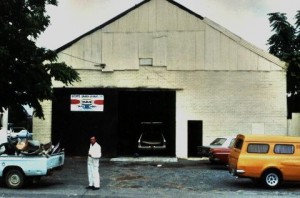
This was one of the few legitimate theatres outside the metropolitan areas of Fremantle and Perth, and held about 500 patrons. It opened on 28 December 1897, well before films were important to the entertainment scene, and was, as its name suggests, a vaudeville theatre primarily, but used for most social events in the district. Local historian Geoff Peel describes it as ´the heart of the town’.
So it was also used for occasional film screenings, including a performance of the multi-media event Soldiers of the Cross, by Commandant Booth of the Salvation Army on 11 October 1901, as well as other visits by the Biorama Company (October 1900, September 1902, February 1904). It was a huge barn-like ‘tin shed’ beside the Guildford Hotel, cold in winter and hot in summer, and not comfortable at any time. Ownership of the building changed whenever the hotel was sold, however the management of the film screenings changed independently of this. When Arthur Nielsen ran the picture business from about 1908, screening one or two nights each week, the hotel (and therefore also the Vaudeville Theatre) was owned by George Hiscock, who also owned the Freemasons Hotel in Midland Junction and the theatre connected with that. From at least December 1910, the films were run by Wilson’s Pictures, and eventually by George Hall, who closed the Vaudeville in 1927 when he opened the Regent Theatre further up the street.
The building remained, however, used at first as a social centre for clubs like the United Kingdom Natives Association and later the Bohemian Club, then as a billiard hall. The slide down-market continued: in 1947 it became a furniture factory, then stood empty for some time before in 1966 being used as a panel beater’s workshop, which continued into the nineties. The corrugated iron construction, including the flytower at the rear, was intact except for a brick facade built after the front wall was weakened by a fire in the seventies. Inside, the bio-box was removed when the front wall was rebuilt, but much of the original sprung timber floor that was so much admired by dancers remained, and part of the proscenium arch (also damaged by the fire) was still visible.
Sources: West Australian, April 1920
Max B. Grace, “Ercildoune”: Guildford reflections 1906-1925, Access Press, Northbridge 1992, pp.52,58
Barrie E. King, ´The Vaudeville Theatre, Guildford, WA’, Kino no.63, Autumn 1998, pp.16-17
Interviews (I. Bertrand): Arthur Nielsen (1978), R. Yelland (1985)
Informants: Geoff Peel (Guildford, September 1997), Margaret Tanner (Guildford, September 1997)
Limelight Picture Show Tours, http//:www.abc.net.au/limelight/docs/tours
Photos: 2 exteriors, colour, 1981 (Bill Turner)
2 exteriors (rear), colour, 1997 (Graeme Bertrand)
1 exterior (runners lining up for start of a race in front of the Vaudeville), b&w, 27 June 1914, Guildford Historical Society
1 exterior, 1897, b&w, Barrie E. King, ´The Vaudeville Theatre, Guildford, WA’, Kino no.63, Autumn 1998, p.16
1 exterior, 1970, b&w, Barrie E. King, ´The Vaudeville Theatre, Guildford, WA’, Kino no.63, Autumn 1998, p.17
1 exterior, 1997, b&w, Barrie E. King, ´The Vaudeville Theatre, Guildford, WA’, Kino no.63, Autumn 1998, p.17
GWALIA
A.W.U. HALL AND SUMMER GARDENS, Kane St, Gwalia
The township of Gwalia grew up around the Sons of Gwalia mine, quite close to the township of Leonora, with a steam tramway linking the two from 1903. Gwalia was mainly a dormitory town for the mine, while Leonora was the commercial centre, but there were times when the population of Gwalia was higher than that of Leonora.
Films were screened in both towns very early. The earliest recorded is a visit of the Salvation Army Biorama Company in October 1902. In November 1910, the King of the West Picture Show was screening regularly (probably weekly) in the Summer Gardens, next to Gwalia’s A.W.U.Hall. In December 1910, a local man (Harry Bradshaw) announced that he had bought a projector and would be screening regularly in both Gwalia (at the A.W.U. Hall) and Leonora, with W.Fletcher as his operator. By January 1911 the Excelsior and the Olympia pictures were in competition – apparently Excelsior (Bradshaw) in Gwalia and Olympia in Leonora, but by January 1913 it seemed that the Excelsior group had won the contest by putting on additional screenings in Gwalia.
Bradshaw continued to dominate in Gwalia, till in 1920 he relinquished ownership and operation of his picture shows in both Gwalia and Leonora to Peoples Pictures, a local committee which purchased Bradshaw’s projector, and announced that profits would be paid into a Distress Fund for needy local people. They continued to screen as usual on Saturday nights in Gwalia, but also screened on Tuesday nights at the Glideaway Skating Rink in Leonora. The first sound films were screened in Gwalia in early 1929, and on Saturday, 31 August 1929, Gwalia saw The Jazz Singer, very soon after the film was seen in Perth. By 1930, Bert Harris was Manager, Secretary and Box Office man for the group, and George Turnbull was Machine Operator and Programme Organiser. By 1936 films were screened twice a week, on Wednesdays and Saturdays, and in 1948 Gwalia Co-operative Pictures sold the business to Consolidated Theatres, who sold it to Alf Peterson, who had moved to Leonora from Agnew after World War II. The venues remained fairly stable throughout all these changes of management.
The AWU hall stood beside the Co-operative Stores, and was constructed of corrugated iron over a timber frame, with a gable roof, no lining, and no ceiling. There may not have been a stage, or a bio-box: the screen probably hung on the end wall. There was no heating: patrons would bring rugs and cushions, and mothers brought their babies in prams and parked them in the aisles. Volunteer fire brigade members were on duty every night: they would walk up and down the aisles, which incidentally also kept the children in order. Different young girls in the town sold the tickets: there was no usher to show patrons to their seats. In the fifties, Alf Peterson or Ken Winter would be the projectionist (while the other was operating at Leonora), and films were switched between the two venues. Refreshments were provided from the café run by Beryl Demasson in Leonora at each interval, and patrons would go over to the cafe after the show for coffee or hamburgers.
Gwalia Gardens was built on the south side of the hall, sharing side walls with the hall and with a shop. There was a high corrugated iron wall across the front of the site, and a lower one across the back. The iron-clad bio-box was free-standing in the middle of the block, and seating was all in deckchairs. As the photo shows, this venue was more an open air show than a true ‘gardens’. In the first week in April the show moved into the hall, because after that the weather was judged too cold for open air presentations.
The show closed in 1960, when the Leonora drive-in opened. By 1966, the population of the town of Gwalia had shrunk to 47.
Sources: C.W.F.Turnbull (compiler), Gwalia-Leonora, Western Australia, 1895-1963, Leonora Tourist Committee 1990
Film Weekly Directory 1940/41 – 1960/61
Interview (Colleen Pead): Alf Peterson (1986)
Interview (Ina Bertrand): Beryl Demasson (1999)
Limelight Picture Show Tours, http//:www.abc.net.au/limelight/docs/tours
Photo: 1 exterior (Gwalia Picture Gardens bio-box, in disrepair), b&w, n.d. (1970s?), Beryl Demasson
GWELUP
ODIN DRIVE IN THEATRE, Odin Rd, Gwelup (Stirling)
This was the first drive-in to be built for Northland Developments. It was built on the west side of Odin Rd, between Corr Place and Amelia St. It had provision for 500 cars when it opened on 31 December 1964, and this was increased to 677 in 1965. By this time, drive-in design was fairly standardised, but there were refinements available which could be presented as progress:
The drive-in has car speakers featuring a new design and cushioned in sponge rubber to completely eliminate any vibration in sound.
The speakers also have rubber protectors to stop windows from being damaged.
In the operating box, the big arc lamps will project a bright, clear picture onto a screen that towers 63ft into the air and is 90 ft wide. (Sunday Times, 27 December 1964)
The usual cafe and playground facilities were also available.
The cinema was purchased by the City Theatres/TVW group in 1979. Around 1985, they considered putting a hard-top on the site (as had been done at the Metro), but a feasibility study showed it would have been uneconomic so they dropped the idea. In 1988, Hoyts took over City Theatres and immediately closed all six drive-ins: the Odin was then sold for $1.34 million, and presented its last screening in July 1988. It was demolished and the land used for a housing estate.
Sources: Film Weekly Directory 1960/1 – 1971
Public Health Department, building permit, Battye 1459
Max Bell, Perth – a cinema history, The Book Guild, Lewes, Sussex, p.128
Kino, no.25, September 1988, p.23; no.26, December 1988, p.23
Sunday Times, 27 December 1964
West Australian, 3 April 1964, 4 August 1965, 20 July 1966, 1965 – 1988
Interviews (Bill Turner): Ray Cooper (1985), Alan Chester (1985)
Photos: 2 exteriors, colour, 1981 (Bill Turner)

